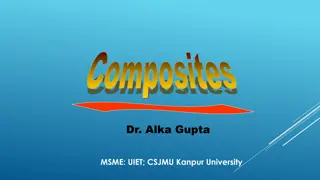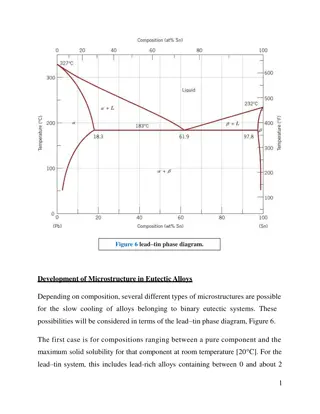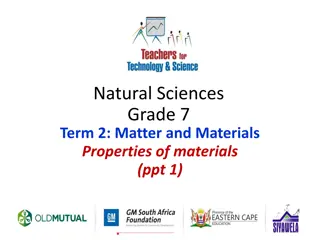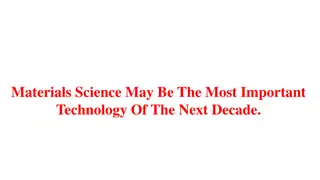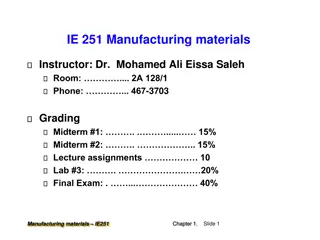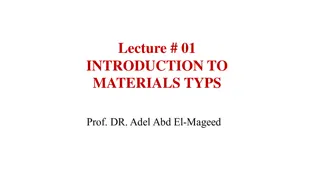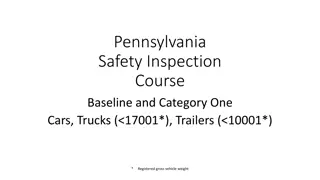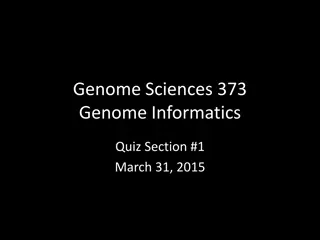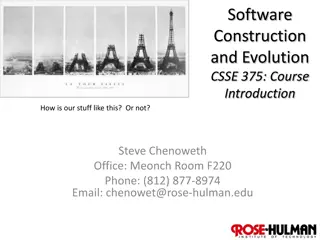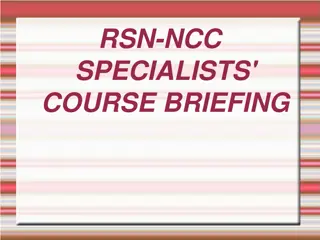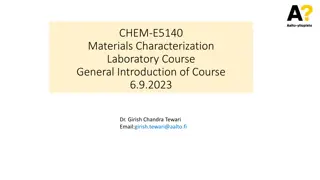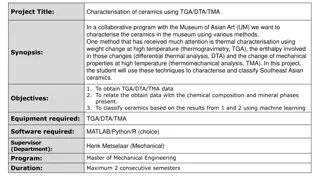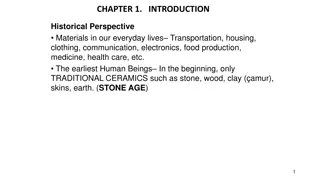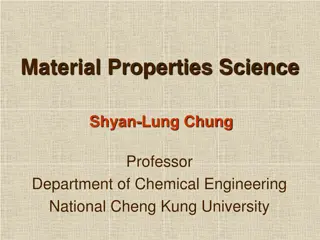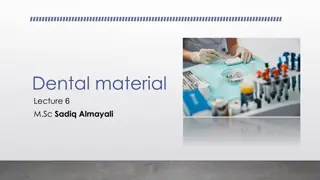Microstructural Evolution in Materials: Course Information
This course on microstructural evolution in materials, led by Juejun (JJ) Hu at MIT, covers topics on light optics, photonics, spectroscopy, imaging, sensing, and more. It includes details on class organization, grading policy, exams, and course schedule. The emphasis is on independent completion of assignments, with lab sessions and TA support. Tips for success include reviewing lecture content, attending office hours, and completing assignments early.
Download Presentation

Please find below an Image/Link to download the presentation.
The content on the website is provided AS IS for your information and personal use only. It may not be sold, licensed, or shared on other websites without obtaining consent from the author.If you encounter any issues during the download, it is possible that the publisher has removed the file from their server.
You are allowed to download the files provided on this website for personal or commercial use, subject to the condition that they are used lawfully. All files are the property of their respective owners.
The content on the website is provided AS IS for your information and personal use only. It may not be sold, licensed, or shared on other websites without obtaining consent from the author.
E N D
Presentation Transcript
MIT 3.022 Microstructural Evolution in Materials 1: Introduction Juejun (JJ) Hu hujuejun@mit.edu
Contact Information Juejun (JJ) Hu Office: 13-4054 hujuejun@mit.edu Office hour: Mon 1-3 pm Research interests We work with light Optics & photonics Spectroscopy, imaging, sensing, photovoltaics, communications,
Class organization Lectures: MWF 10-11 (4-231) Lab sessions: 02/25-03/04, 04/01-04/08, 04/29-05/06 Recitations: TR11 or TR12 (13-3101) TAs: Qian Song, qiansong@mit.edu; Cindy Shi, cindyshi@mit.edu Office hours: Tue 4-5 (13-4101), Th 4:30-5:30 (13-4106) Learning Modules site Syllabus, class schedule, announcements, lecture slides, assignments, exam solutions will be posted on the website No required textbook
Grading policy Mid-term 1 (Mar. 20): 15% Mid-term 2 (Apr. 24): 15% Final (TBD): 25% Homework assignments: 15% Discussions are allowed and encouraged; but you are supposed to complete the assignments independently We do NOT accept late submissions Lab: 30%
Exams Exams will be closed book (no laptop, cell phones, etc.): no phone calls, texting, or collaboration is allowed. However, you will be allowed to bring one (mid-terms) or three (final) A4- or letter-sized sheets to the exam. You may print/write whatever you want on the sheets (equations, formulae, definitions, drawings, etc.) No font/margin requirement Magnifying lenses or microscope (!!!) prohibited in exams Calculators are allowed
Course schedule Posted online No late submissions will be accepted (see below) If you need to reschedule an exam or have to postpone a submission E-mail TA and instructor at least 24 hours in advance A valid reason A statement from S^3 Make-up exams are scheduled before or on the same day as the exams
Some tips Review 3.012 Focus on the lectures in class Lectures and slides cover all the information you need to know Slides will be posted online prior to classes: preview slides before class and print them out If there is a question, ask Review lecture content after every lecture Make use of office hours Complete PSets early
More about the homework & exams Homework assignments are divided into two parts Calculations Concepts & real-world applications Exams focus on conceptual questions
What will you learn from this course? There WILL be another surge of the stock market. Thermodynamics What will happen? Statistical Mechanics Why would it happen? Kinetics Credit: KDS4444, CC BY-SA 4.0 But WHEN??? When will it happen?
Consider one mole of Ar gas in a container A thermodynamic description: The gas is fully characterized by a set of macroscopic parameters in equilibrium: Pressure P, temperature T, volume V These parameters are called state functions Microscopically, these parameters have specified very little information about the system (gas)!
Consider one mole of Ar gas in a container The classical deterministic approach: 6 1023 atoms: 3 6 1023 degrees of freedom (DOF) Two parameters (coordinate q and momentum p) associated with each DOF at any instant of time If we know all these 2 3 6 1023 parameters at a given time, in principle we can use classical mechanics to predict the evolution Need to know the initial conditions exactly! Each macroscopic equilibrium state corresponds to many microscopic states
Three-body problem and the butterfly effect Three-body gravitational interaction https://evgenii.com/blog/three-body-problem- simulator/ Extreme sensitivity to initial values Chaos theory One flap of a seagull's wings could change the course of weather forever Rapidly amplifies any measurement or computation error
Consider one mole of Ar gas in a container The statistical mechanics approach: Derive the statistical ( average ) behavior of gas molecules based on the law of mechanics Ensemble: a large number of virtual copies of a system, each of which represents a possible microscopic state that the real system might be in subjecting to certain constraints Time average of mechanical variables equals ensemble average
Microcanonical ensemble Boundary condition: system energy and volume are kept constant Gas molecule Elastic process Rigid, thermally insulating walls The fundamental postulate: given an isolated system in equilibrium, it is found with equal probability in each of its accessible microstates
Microcanonical ensemble Example: if no external force acts on the molecule, it has equal probability to be found in any location inside the container Probability of finding the molecule in either side 50% 50% Gas molecule Rigid, thermally insulating walls
Microcanonical ensemble Assume that all the N molecules do not interact with each other The probability of having N1 molecules on the left side and N2 molecules on the right side (N = N1 + N2) is: ! N ( ) = P N 1 ! ! N N 1 2 ( ) P N 1 N width 2 /N 0 Rigid, thermally insulating walls N 2 N 1
Fluctuations Random deviations from statistical mean values Exceedingly small in macroscopic systems Fluctuations can be significant in nanoscale systems A transistor (MOSFET) with a gate length of 50 nm contains only ~ 100 electrons on average in the channel. Fluctuation of one single electron can lead to 40% change of channel conductance! Credit: Wgsimon, CC BY-SA 3.0
Statistical interpretation of entropy The function S has the following property: in equilibrium, S maximizes in an isolated system Entropy: = ln S k in an isolated system : number of accessible microscopic states (degeneracy of macrostate) An isolated system tends to evolve towards a macroscopic state which is statistically most probable (i.e. a macroscopic state corresponding to the maximum number of microscopic accessible states)
Entropy is an extensive variable Two systems with no mutual interactions = + = S S S 1 2 1 2 tot tot Gas molecule One molecule N independent classical molecules = = = = N S S , S NS , 1 1 1 1
Entropy maximization in isolated systems Remove constraint N, Vf > Vi N, Vi Classical thermodynamics: Statistical mechanics: Removal of constraint leads to increased entropy Removal of constraint leads to increased number of accessible microstates S S f i f i = 0 S S S Probability of the system remaining in the initial state: P = f i Irreversible process ~ 0 i i f
Summary What is the thermal equilibrium condition? Each macroscopic equilibrium state corresponds to many microscopic states Statistical interpretation of the 2nd law: thermal equilibrium in an isolated system corresponds to the statistically most likely state Equilibrium state of macroscopic systems can be identified by finding the maximum of the probability distribution function What defines the thermodynamic parameters of a macroscopic system? Statistical ensemble Time average of mechanical variables equals their ensemble average The fundamental postulate Fluctuation
Entropy = ln S k Entropy is a measure of the accessible microscopic states in a system Ludwig Boltzmann (1844-1906) Credit: Daderot, CC BY-SA 3.0 Now it is our turn to study statistical mechanics ! Paul Ehrenfest (1880-1933)
List of symbols P probability N number of molecules/particles S entropy k Boltzmann constant (1.38 10-23m2kg s-2K-1) Number of microscopic states V Volume Subscript i represents initial state and f denotes final state






